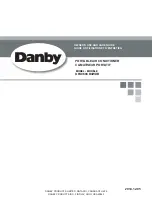
•Make sure the power is off and the unit is unplugged
before open-ing the unit to troubleshoot or repair
electrical parts and wiring.
•Keep your fingers and clothing away from any moving
parts.
•Clean up the sight after you finish, making sure no
metal scraps and wiring are left in the unit.
•The Air conditioner shall be installed in accordance
with the na-tioned wiring regulation.
•The equipment fulfills the requirements in EN 61 000-
3-11 and is subject to conditional connection to the
mains.
•It may be connected in consultation with the supply
authority.
•The equipment may only be connected to a mains
supply with a system impedance of less than 0.3 ohm.
•The system impedance in the interface point may be
obtained from the supply authority.
•If the mains supply has a higher system impedance,
short voltage dips may appear when the equipment is
started or during opera-tion.
•This may influence or disturb the operation of other
apparatuses, e.g. flickering lamps, especially those
connected to the same supply mains.
ROOM AIR CONDITIONER INSTRUCTION
Remark per EMC Directive 89/336/EEC
To prevent flicker impressions during the start of the
compressor (technical process) following installation
conditions do apply.
1. The power connection for the air conditioner has to be
done at the main power distribution. This distribution
has to be of an low impedance. Normally the required
impedance is reached at a 32A fusing point. Air
conditioner fuse has to be 16A max!
2. No other equipment has to be connected to this power
line.
3. For detailed installation acceptance please refer to your
contract with the power supplier. If restrictions do apply
for products like washing machines, air conditioners or
electrical ovens.
4. For power details of the air conditioner refer to the
rating plate of the product.
When Servicing:
Safety Instructions ....................2
Names of Parts...........................4
Indoor Unit ...............................................4
Outdoor Unit ............................................4
Remote Controller ...................................5
Operation ....................................6
Prior to Operation ....................................6
Auto Operation ........................................7
Cooling Operation ...................................8
Fan Operation..........................................9
Dehumidification Operation ..................10
Heating Operation .................................11
Additional Operation...............12
Setting the time Operation ....................12
Lamp Operation.....................................12
Airflow direction control operation ........13
Sleep Operation ....................................14
Turbo Operation ....................................14
Plasma Operation .................................15
Focus/Wide Operation ..........................15
Emergency Operation...........................15
Maintenance .............................16
Troubleshooting Guide...........18
Contents
Disposal of Used Electrical &
Electronic Equipment
The meaning of the symbol on the product, its
accessory or packaging indicates that this
product shall not be treated as household
waste. Please, dispose of this equipment at
your applicable collection point for the
recycling of electrical & electronic equipments waste. In the
European Union and Other European countries which there
are separate collection systems for used electrical and
electronic product. By ensuring the correct disposal of this
product, you will help prevent potentially hazardous to the
environment and to human health, which could otherwise be
caused by unsuitable waste handling of this product. The
recycling of materials will help conserve natural resources.
Please do not therefore dispose of your old electrical and
electronic equipment with your household waste. For more
detailed information about recycling of this product, please
contact your local city office, your household waste disposal
service or the shop where you purchased the product.




































